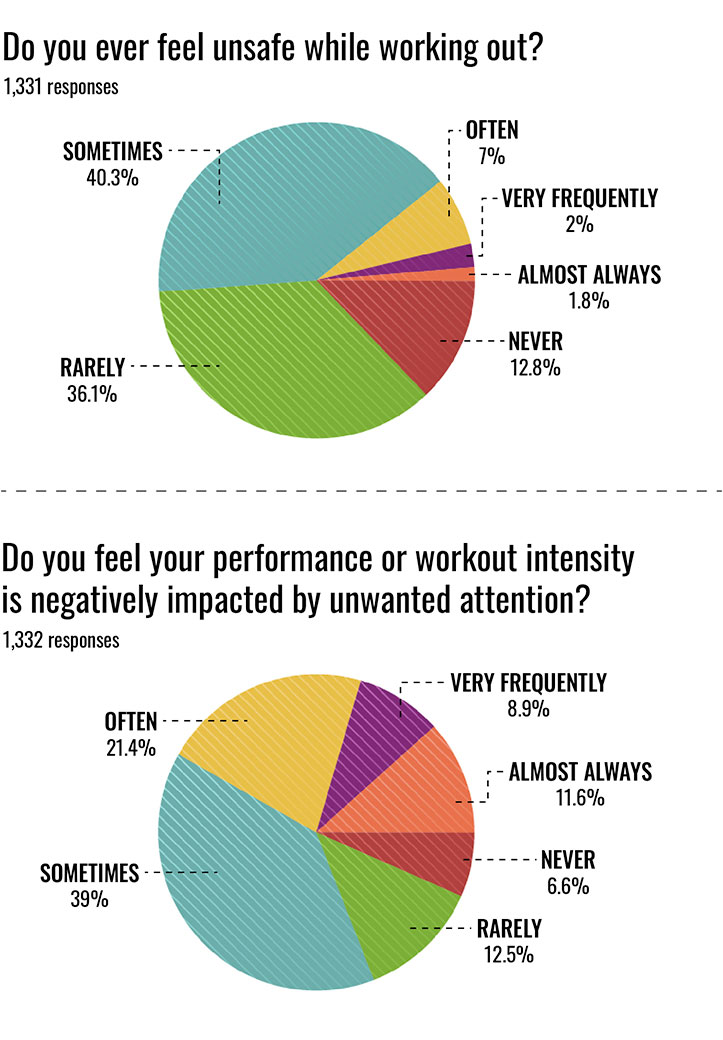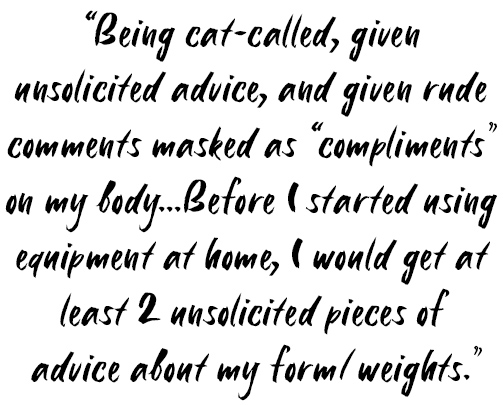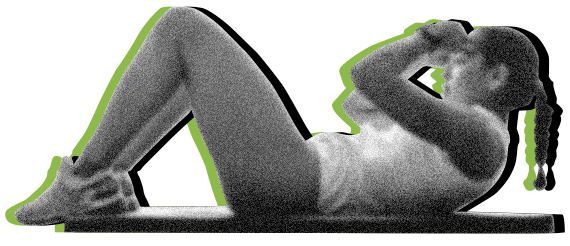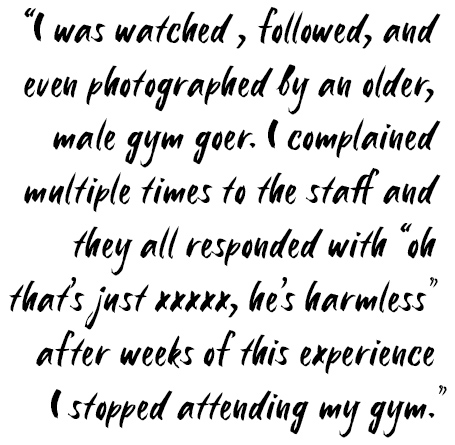Warning: This article contains stories of harassment against women.
BarBend recently conducted an online survey to understand how pervasive harassment is in training environments, and specifically how it is affecting women in the gym. The results of the survey showed widespread harassment in various types of training facilities, perpetrated by fellow members, by trainers and staff, and by owners of facilities.
In the survey, women described methods of addressing the harassment that have been met with mixed results, from reporting harassment to management personnel to changing the clothing they wore to the gym. The findings of this survey suggest there is still a lot of work to be done in order to make gyms and training environments safe, respectful, and enjoyable for all.
The Main Takeaways:
- More than half of women surveyed report feeling unsafe in training environments “sometimes,” “often,” “very frequently,” or “almost always.”
- What makes women feel unsafe? Staring, following, persistent sexual pursuit in person and via social media, comments on their appearance, and more.
- All gym members and training facilities are responsible for creating training spaces that support women.


The purpose of this survey was to:
1) Understand the scope of harassment in gyms: how women are harassed and how often it happens.
2) Understand the impact of the harassment and identify solutions to the problem.
The survey was completed by over 1300 individuals, most responding within 24 hours of the survey opening. Over ninety-eight percent of respondents identified as female. Respondents were overwhelmingly from the United States, but we also received responses from women in Canada, Australia, South Africa, and throughout Europe. Importantly, the survey also offered space for respondents to share their experiences with harassment, which a large number of survey-takers did.
The Numbers
From the data, one thing is abundantly clear: harassment of women is widespread in training facilities, and the harassment women experience there has a negative mental, emotional, and physical impact on them and their training.

- Only 12.8% of respondents reported never feeling unsafe in a training environment. This means 87.2% report having felt unsafe at the gym: 4 out of every 5.
- Only 6.6% of respondents reported that their workout performance or intensity was unaffected by unwanted attention at the gym, meaning 93.4% of these athletes have been disrupted in their workouts: 9 out of 10.
- Over 1,000 of our respondents, about 75% of them reported being heckled or catcalled at least once per week while working out. That’s 3 out of 4 women.
- 76.2% of respondents have received unsolicited training advice and guidance at the gym: 3 out of 4 women.
- 63.8% of respondents have changed gyms or altered their training schedules to avoid harassment: 3 out of 5.
- 55.7% of respondents have changed the way they dress to avoid harassment: more than half.


What Behavior Harms Women and Why?
In reviewing the experiences shared by respondents, a theme arose of women being told that the people harassing them were “harmless.” Yet it’s clear that women are harmed by harassment, even when there appears to be no physical threat. Harassment doesn’t always stem from physical gratification. Like bullying, harassment is often about establishing and maintaining a balance of power, in this case, one that favors men. Unwanted behavior is unwanted behavior. The intent of actions directed toward women at the gym, even if they are meant as benevolent or complimentary, does not justify the behavior if a woman perceives it as harassment.
Based on our survey, women in training environments can expect to have their experience and knowledge assumed to be inferior to men’s and to be treated with hostility that’s cloaked in concern or sexual interest. Interactions like the ones described in this survey create low self-worth, anxiety, and distraction in an environment that should positively affect mental health. The importance of men and training facilities understanding the harm that harassment causes women can’t be understated.
The specific types of behavior that harm women and their training varies widely. What follows is a selection of experiences offered with the goal of:
1) Raising awareness so that women experiencing harassment learn that they are not alone.
2) Demonstrating to other gym-goers and training facilities that harassment is extremely harmful, ubiquitous, and is a problem that we need to solve together.

Staring
Aggressive eye contact is a form of challenge. One respondent shared, “There was this older man (maybe 40s) that I noticed staring at me, like he wanted me to notice him. And when I caught him staring, he didn’t look away, he kind of looked me up and down and then continued staring straight at me. Throughout my entire hour at the gym he never stopped staring at me.” Women who shared stories like these describe severe anxiety and fear in response. Considering that a man staring at another man in this manner also causes tension, this is understandable. As one respondent pointed out, “I feel like it’s an ego/power trip for them.”
Following
Several respondents reported not only being followed around the gym as they trained, but being followed out to their cars and even home from the gym. One woman “had to cut down numerous side streets and blow a red light to lose the car [she] was being followed by…” Being followed is a violation of privacy, and depending on where a person lives, it may qualify as stalking.
Being Engaged in Unwanted Conversation
About 75% of respondents reported being engaged in unwanted conversation. Going to the gym is time allocated for personal growth and to become healthier. When it’s disrupted, the mental and physical health benefits of exercise are also disrupted. Women wearing headphones and intentionally not making eye contact have had their “headphones ripped out of [their] ear mid press” or “headphones pulled out and hair twirled around fingers,” all to be told that they are beautiful or doing a great job. These seem like compliments, but as one woman put it, it’s “the lack of respect and decency for me, my space, my growth, my dedication” that makes this behavior unwelcome.
Repeated Requests for Dates or Phone Numbers
“No means no” apparently hasn’t sunk in at gyms. About 30% of respondents experienced being asked for their number or for dates repeatedly. Persisting in asking for dates or numbers after being denied is not only awkward, it’s disrespectful.
Comments About Body
Unsolicited comments on anyone’s body, whether compliments or insults, are a form of judgment that is largely unwelcome. About 66% of respondents experienced hearing comments about their body, many of them casual remarks to the woman, like sharing what types of outfits they like to see women wear or that they “love the view.” If compliments about the body are generally unwelcome, then insults are even more so. Women also reported hearing “extremely sexist comments about both [their] strength and body type” and being fat-shamed. Catcalling has happened to 33% of respondents. Whether it’s intended as a compliment or an insult, these comments often reduce a woman’s value to her appearance.


Taking Video or Photos without Consent
This is clearly harassment according to the responses we received: 91% of respondents said they considered it so. Like being followed, this is an invasion of privacy, and it’s overtly sexual in nature. One respondent shared, “ I thought the guy just didn’t know what he was doing…he had a buddy film him spotting me so he could record himself “tea bagging” me when I was benching.” One in three women in the survey reported having video or photos taken of them without their consent.
Social Media Harassment and Stalking
This is one form of harassment that our survey didn’t ask about, however the stories shared by respondents tell us that online harassment is both prevalent and harmful. It’s apparent that certain men are using the safety of an online buffer to harass women in ways they wouldn’t in person. “He never spoke to me but found me on Instagram and sent me gross messages” was a common storyline. Not only did women describe men commenting on posts inappropriately or sending unwelcome DMs, they described online stalking: finding their location based on their Instagram posts. As one respondent said, “having someone stalk you and find you online is terrifying.”
Having Personal Space Invaded
Invading someone’s personal space is a challenge and a threat. “He would corner women in the gym on their way to the bathrooms and make them feel really uncomfortable, as if they couldn’t escape,” one respondent shared. Sixty-six percent of respondents reported having their personal space invaded at the gym, 2 in 3 women.


Being Touched or Groped and Being Rubbed Against
Being touched is another violation of personal boundaries. “Touching” is sometimes veiled in friendliness, for example on the arm, where groping is overtly sexual in nature. In our survey, fourteen percent of women reported being touched or groped and 15.7% reported being rubbed against.
Several respondents shared stories of men “spotting” them in order to have an excuse to grope them. For example, one woman reported “3 occasions where men will “spot” me on a squat WITHOUT being asked…and grab me at the chest and thrust [their] hips into mine.”
Social Media Harassment and Stalking
Being touched is another violation of personal boundaries. “Touching” is usually veiled in friendliness, for example on the arm, where groping is overtly sexual in nature. In our survey, fourteen percent of women reported being touched or groped and 15.7% reported being rubbed against.
Several respondents shared stories of men “spotting” them in order to have an excuse to grope them. For example, one woman reported “3 occasions where men will “spot” me on a squat WITHOUT being asked…and grab me at the chest and thrust [their] hips into mine.”
Unsolicited Advice
Receiving unsolicited advice or guidance is a major problem for women in gyms: 76.2% of women have experienced it. There is a difference between holding an opinion and giving it: giving it implies that the opinion is valuable and needed to the person hearing it, regardless of the experiences, knowledge, and background of the listener and the speaker. One respondent shared an experience where a man stopped her workout (she had headphones in) to give her unsolicited diet advice, not knowing that she was not trying to lose weight. Many others described being corrected on form. In one example, “he kept asking me to show me my form…and I told him no and to look up sumo deadlift form on Youtube. Turns out, he didn’t even know what sumo deadlifts are.” Several women who described this behavior were experienced lifters and personal trainers.
As another respondent shared, “ I don’t see any random men going up to other men and doing that. My male friends have also never experienced that.”
The common themes that arise as we look at harassment are that 1) women are specifically targeted, 2) they are made to feel inferior to men, and 3) this causes harm to them mentally, emotionally, and physically. Many respondents shared that they quit working out due to the prevalence of harassment in gyms or modified their workouts to avoid certain movements. Forty-one percent of women reported in the survey that their workout intensity was affected by harassment often, very frequently, or almost always.
[Read More: Best Online Personal Trainers, Approved by Our Team of Trainers]


What Are Women Doing to Address Harassment?
Women came up with many ways to address the harassment they were receiving, with mixed results: sometimes it helped and sometimes it made no difference.
Changing Dress
More than half of women have adjusted what they wear in order to avoid being harassed, and while many of them recognize that clothing is not consent, they find that wearing baggier clothing allows them to avoid more unwanted attention and to focus on their workouts. This means being less comfortable physically. As one respondent said, “I overheat from wearing hoodies and sweatpants all the time. I just want to be treated as an equal in the gym, not as something to look at.”
Changing Times or Gyms
About 2 in 3 women in our survey have changed the times they train or the gym they train at in order to avoid harassment from certain members, sometimes more than once. Some women found that switching to different types of training environments, particularly “boutique” or specialty gyms, ones focused on powerlifting or strongman, helped, and others found that training from home was their only option for avoiding harassment.
[Read More: The Best Online Workout Programs, Tried and Tested]
Being Unapproachable
Many women have used headphones or “resting bitch face” in order to signal that they were uninterested in interaction. As we explored earlier in the section on unwanted conversation, this is often not a deterrent, with men removing headphones or waving their hands in women’s faces to get their attention.
Bringing Male Training Partners
Having the presence of a male training partner appears to be effective at curbing harassment. The problem with this method is that, as one respondent described, as soon as they go to the gym alone, “the men always pounce…they think I’m suddenly… single.”
Reporting to Management
Reporting to management would ideally be the end of experiencing harassment, and in some cases it was: members were banned or given warnings that resulted in the harassment ending. In other cases, even after multiple warnings, harassment continued. Worse, many respondents shared that their reports of harassment were dismissed. In one case, blatant sexual harassment in the form of a man putting “his balls on [a woman’s] forehead while spotting [her] on bench press” resulted in management responding that “it was just a joke and to stop complaining.” Reporting to management is difficult to do when women are concerned about their reports being believed, and it’s even more so when owners, gym staff, or trainers are the ones responsible for the harassment.
Confronting Harassers
Some women turned to confronting their harassers directly, through assertiveness or threats, often after reporting to management was ineffective. This carries risk, as some stories show that men told directly to stop then escalated their harassment, though others found it effective.
What Gym-Goers Can Do to Create Safe Training Spaces?
Women currently bear the burden of addressing harassment, yet the responsibility for harassment is not ours. Working together, it will require bravery from all of us — from gym-goers to training spaces — to disrupt the environments where harassment flourishes.
- When women tell you about harassment, listen, rather than offering advice, solutions, or excuses. Responses that are helpful may sound like: “I’m so sorry that happened” or “I’m sorry I did that, I’ll do better.”
- Avoid giving unsolicited advice at any time, especially at the gym.
- No means no. Asking a second time for a date, phone number, to talk to or help them, you are engaging in harassment.
- If you have a friend following women around the gym or making comments about women’s bodies? Call them out on it. Hold the people in your life accountable.
- Believe women. Don’t ask if they’re sure it was “meant that way” or if it really happened the way they describe.
- Confront toxic masculinity. The need to perform masculinity in the form of aggression and hypersexual behavior is a symptom of toxic societal expectations of male behavior, and it harms both men and women.
- Demand that harassment in your gym environment be addressed by the management. Wherever possible, only give your business to training centers that foster safety and respect for all members.
- Avoid victim-blaming. What women wear or how they choose to interact with others is not the problem. Personality and experience all play a role in how other women cope with harassment. Remember that the problem is the harassment, not the harassed.
- This also applies if you are the one being harassed. You deserve care and respect.
- Report any behavior that makes you uncomfortable. Trust your intuition. As one participant wrote:
“Sometimes I even thought it was complimentary, but then as I researched the topic, I realized that the negative way I felt after “compliments” was a gut reaction in a threatening environment.”
Always put your reports in writing and put any responses of the management team in writing.
Keep messages received over social media for reporting, but for your safety, do not respond.
- Women are socialized to “be nice,” which is code for not having boundaries. You are entitled to move through the world without having interactions that make you uncomfortable. Assertiveness training can be helpful.
- Be aware of your rights, especially to privacy. Gym staff do not have a right to disclose any information about you and members who are following you or using your social media to locate you may be stalking you. You have legal recourse in these cases.
- Wherever possible, only give your business to training centers that foster safety and respect for all members.
- Many women can’t change gyms due to pricing. If your gym is a safe and respectful place, ask them to create a program that allows members to contribute to a fund for those who can’t afford a safe place to train.
[Read More: The Best Workout Apps for Women]
The Responsibilities of Training Spaces
The responsibility for the culture in a training space is up to the training space, and the harassment of women in training spaces is prevalent enough that every single gym owner needs to be concerned.
- Harassment is not “harmless.” When a member reports discomfort, anxiety, or fear, take it seriously.
- Ask for input on your harassment policies from women. Most policies are written with the intention of protecting a business from litigation, rather than protecting women. This tends to discourage reporting, not abuse.
- Hire a diverse staff and listen to them. Diverse perspectives catch gaps in understanding and policy that allow harassment to flourish.
- Educate and empower your team members to stop harassment. A disturbing number of stories indicated that staff were not only dismissive of reports of harassment, they were often responsible for it. Ensure your staff knows not to give out personal information about members.
- Some gyms are outside of the price range of athletes who need a safe and respectful space to train. Create a program for your members to contribute to that will allow you to offer discounted memberships to athletes who need them.
Conclusion
This survey is only a starting point. Currently, women bear the burden of managing the harassment they receive. What is ultimately going to end harassment is the entire fitness community (and beyond) working together to create safe and respectful training spaces, not only for women, but for everyone training to be stronger each day.




